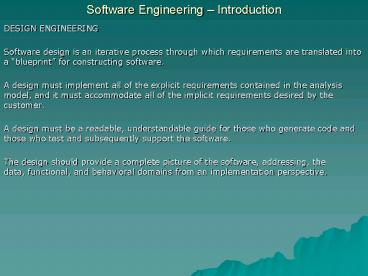Software Engineering Introduction - PowerPoint PPT Presentation
1 / 16
Title:
Software Engineering Introduction
Description:
the manner in which these components interact, the structure of data that are used by the components. Software Engineering Introduction ... – PowerPoint PPT presentation
Number of Views:20
Avg rating:3.0/5.0
Title: Software Engineering Introduction
1
Software Engineering Introduction
- DESIGN ENGINEERING
- Software design is an iterative process through
which requirements are translated into a
blueprint for constructing software. - A design must implement all of the explicit
requirements contained in the analysis model, and
it must accommodate all of the implicit
requirements desired by the customer. - A design must be a readable, understandable guide
for those who generate code and those who test
and subsequently support the software. - The design should provide a complete picture of
the software, addressing, the data, functional,
and behavioral domains from an implementation
perspective.
2
Software Engineering Introduction
- DESIGN ENGINEERING
- FURPS Functionality, Usability, Reliability,
Performance, and Supportability.
3
Software Engineering Introduction
- DESIGN ENGINEERING
- FURPS Functionality, Usability, Reliability,
performance, and supportability. - Functionality assessed by evaluating
- the feature set
- capabilities of the program.
4
Software Engineering Introduction
- DESIGN ENGINEERING
- FURPS Functionality, Usability, Reliability,
Performance, and Supportability. - Usability - assessed by considering
- human factors,
- overall aesthetics,
- consistency,
- end-user documentation.
5
Software Engineering Introduction
- DESIGN ENGINEERING
- FURPS Functionality, Usability, Reliability,
Performance, and Supportability. - Reliability is evaluated by measuring
- the frequency and severity of failure,
- the accuracy, of output results,
- the mean-time-to-failure,
- the ability to recover from failure,
- the predictability of the program.
6
Software Engineering Introduction
- DESIGN ENGINEERING
- FURPS Functionality, Usability, Reliability,
Performance, and Supportability. - Performance is measured by
- processing speed,
- response time,
- resource consumption,
- throughput,
- efficiency
7
Software Engineering Introduction
- DESIGN ENGINEERING
- FURPS Functionality, Usability, Reliability,
Performance, and Supportability. - Supportability combines
- the ability to extend the program
(extensibility), - adaptability,
- serviceability
- testability,
- compatibility,
- configurability.
8
Software Engineering Introduction
- DESIGN ENGINEERING
- Abstraction is one of the fundamental ways that
we as humans cope with complexity. Grady Booch - What kinds of things do we abstract?
9
Software Engineering Introduction
- DESIGN ENGINEERING
- Abstraction is one of the fundamental ways that
we as humans cope with complexity. Grady Booch - What kinds of things do we abstract?
- data
- objects
- procedures
- modules
- just about anything
10
Software Engineering Introduction
- DESIGN ENGINEERING
- Abstraction is one of the fundamental ways that
we as humans cope with complexity. Grady Booch - What kinds of things do we abstract?
- data
- objects
- procedures
- modules
- just about anything
11
Software Engineering Introduction
- DESIGN ENGINEERING
- ARCHITECTURE
- Software architecture alludes to the overall
structure of the software and the ways in which
that structure provides conceptual integrity for
a system. - Architecture is
- the structure or organization of program
components (modules), - the manner in which these components interact,
- the structure of data that are used by the
components.
12
Software Engineering Introduction
- DESIGN ENGINEERING
- PATTERNS
- A pattern is a named nugget of insight which
conveys the essence of a proven solution to a
recurring problem within a certain context amidst
competing concerns. - Each pattern describes a problem which occurs
over and over again in our environment, and then
describes the core of the solution to that
problem, in such a way that you can use this
solution a million times over, without ever doing
it the same way twice. Christopher Alexander
13
Software Engineering Introduction
- DESIGN ENGINEERING
- MODULARITY
- Software is divided into separately named and
addressable components, sometimes called modules,
that are integrated to satisfy problem
requirements.
14
Software Engineering Introduction
- DESIGN ENGINEERING
- INFORMATION HIDING
- Modules should be specified and designed so that
information (algorithms and data) contained
within a module is inaccessible to other modules
that have no need for such information. - This means that inadvertent errors introduced
during modification are less likely to propagate
to other locations within the software. - Changes to the internal representation of one
module should have not have an effect on other
modules.
15
Software Engineering Introduction
- DESIGN ENGINEERING
- FUNCTIONAL INDEPENDENCE
- Functional independence is achieved by developing
modules with single-minded function and an
aversion to excessive interaction with other
modules. - We want to design software so that each module
addresses a specific subfunction of requirements
and has a simple interface when viewed from other
parts of the program structure. - Independence is assessed by using two qualitative
criteria - Cohesion How related a module is to itself. It
should perform a single task and require little
interaction with the rest of the program. - Coupling is an indication of the interconnectoin
among modules in a software structure.
16
Software Engineering Introduction
- DESIGN ENGINEERING
- REFINEMENT
- Stepwise refinement is when a program is
developed by successively refining levels of
procedural detail. - Refinement is actually the process of
elaboration. - REFACTORING
- Refactoring is a reorganizational technique that
simplifies the design )of code) of a component
without changing its function or behavior.

